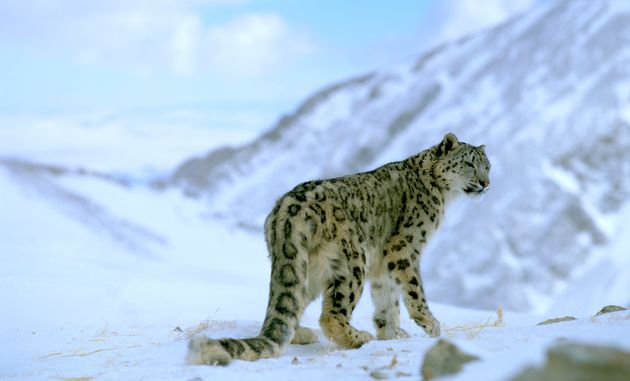Posted: 10/22/2015

Climate change is unforgiving when it comes to the world's most enigmatic species. Penguins have been forced to climb cliffs to breed as sea ice melts. Polar bears are starving to death as they lose the means to hunt. And coral reefs around the globe are turning ghostly white.

Climate change is unforgiving when it comes to the world's most enigmatic species. Penguins have been forced to climb cliffs to breed as sea ice melts. Polar bears are starving to death as they lose the means to hunt. And coral reefs around the globe are turning ghostly white.
Now, according to a report released this week by the World Wildlife Fund, we have another creature to add to a growing list of the imperiled. Populations of snow leopards, considered among the most elusive big cats on the planet, have declined more than 20 percent over the past 16 years. Should climate change continue unchecked, more than a third of the animals' limited habitat may disappear.
The conservation group calls for urgent international action to protect these "ghost cats," which live some 3,000 meters above sea level in the rocky mountains of Central Asia. There may be fewer than 4,000 snow leopards left in the wild. The animals have been classified by the International Union for Conservation of Nature as endangered since the mid 1980s.
Some of the prime drivers of the species' decline are familiar -- hunting, poaching, retribution killing by communities that lose livestock. But snow leopards are highly adapted to the snow-covered peaks far from humanity, with a coat that makes them near invisible when the weather is right.
Because climate change poses such a great threats to the planet's cold places, including arid Asian mountain biomes, the cats themselves are at the mercy of a warming world.
Along with melting sea ice and the thawing of the permafrost, the WWF warns that even slightly warmer temperatures may compel farmers to plant crops higher up the mountains in leopard territory. These farmers bring along sheep, which eat the grass that feeds the big cats' prey. And retribution killings due to conflict with humans are likely to rise as part of a climate-induced domino effect.
“Urgent action is needed to curb climate change and prevent further degradation of snow leopard habitat, otherwise the ‘ghost of the mountains’ could vanish," Rishi Kumar Sharma, the global snow leopard leader for the WWF, said in a statement.
The WWF notes that some 330 million people rely on water that comes directly from sources within the snow leopard's habitat range. These sources may very well dry up, should the snow, ice and permafrost disappear because of climate change.
So what's to be done? Unlike the United States, where endangered species and their habitats are given strict protections, a large swath of the snow leopard's range remains unpreserved. Less than 14 percent of the the animal's habitat has been covered by either research or conservation activities.
The New York Times notes that, to Americans, snow leopards are "perhaps
the most beloved members of the great cat club." The WWF wants the
world to embrace this attitude to develop broad conservation plans among
the 12 countries snow leopards inhabit.
Conservation will be a prime talking point during December's climate summit in Paris, where hundreds of world leaders are expected to hash out a plan to tackle climate change. The planet has officially entered the first "mass extinction" event since the dinosaurs, and species are disappearing far faster than ever.
Time really is of the essence for species on the brink of extinction. It just depends how much time, and money, humanity is willing to spend to save them.
source
No comments:
Post a Comment